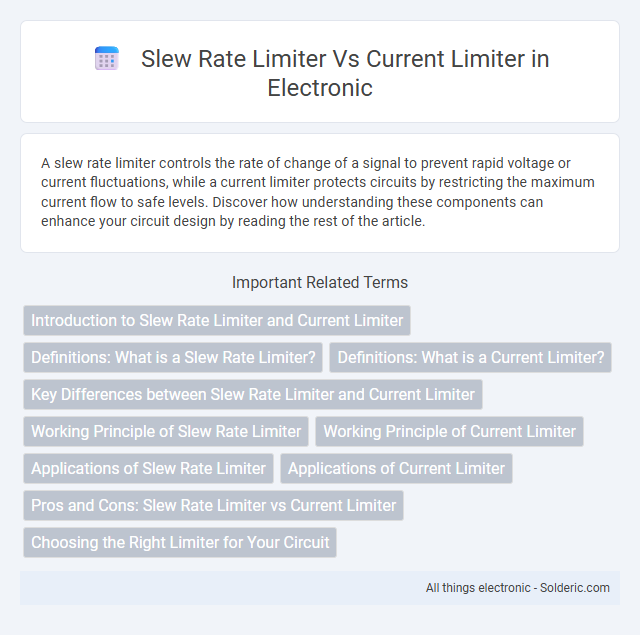A slew rate limiter controls the rate of change of a signal to prevent rapid voltage or current fluctuations, while a current limiter protects circuits by restricting the maximum current flow to safe levels. Discover how understanding these components can enhance your circuit design by reading the rest of the article.
Comparison Table
| Feature | Slew Rate Limiter | Current Limiter |
|---|---|---|
| Purpose | Controls the rate of voltage or signal change over time | Limits the maximum current to prevent damage |
| Primary Parameter | Slew rate (V/us) | Current (Amperes) |
| Function | Prevents rapid voltage transitions to reduce signal distortion and electromagnetic interference | Protects circuits from overcurrent conditions and thermal damage |
| Typical Applications | Signal conditioning, amplifiers, DAC output smoothing | Power supplies, motor drivers, battery charging circuits |
| Implementation | Analog or digital circuits controlling voltage rate of change | Resistors, transistors, or dedicated current sensing ICs |
| Impact on Performance | Limits bandwidth and speed of signal transitions | Ensures safe operating current, may limit load performance |
| Typical Components | Op-amps, capacitors, RC networks | Shunt resistors, current sense amplifiers, PTC fuses |
Introduction to Slew Rate Limiter and Current Limiter
A slew rate limiter controls the rate of change of voltage or current to prevent rapid transitions that can cause distortion or damage in electronic circuits. In contrast, a current limiter restricts the maximum current flowing through a circuit to protect components from overcurrent conditions. Both devices are essential for maintaining circuit stability and preventing damage, with the slew rate limiter managing signal dynamics and the current limiter ensuring safe current levels.
Definitions: What is a Slew Rate Limiter?
A slew rate limiter is an electronic circuit that controls the rate of change of a signal voltage over time, preventing rapid transitions and ensuring smooth, gradual shifts. It limits how quickly an output can respond to an input signal, often measured in volts per microsecond (V/us), protecting sensitive components from abrupt voltage spikes. Understanding the difference between a slew rate limiter and a current limiter is crucial for optimizing your circuit's performance and safeguarding your electronics.
Definitions: What is a Current Limiter?
A current limiter is an electronic circuit or device designed to prevent excessive current flow by restricting the current to a safe, predefined maximum level, protecting components from damage. In contrast, a slew rate limiter controls the rate of change of voltage or current to avoid rapid spikes and noise in signals. Understanding how your current limiter maintains electrical safety can help optimize system reliability and prevent overheating or component failure.
Key Differences between Slew Rate Limiter and Current Limiter
A slew rate limiter controls the rate of change of a signal, preventing rapid voltage or current transitions to protect sensitive components and ensure signal integrity. In contrast, a current limiter restricts the maximum allowable current in a circuit to prevent damage from overcurrent conditions. While slew rate limiters focus on signal dynamics, current limiters prioritize component safety by managing current levels.
Working Principle of Slew Rate Limiter
A slew rate limiter controls the rate of change of an electrical signal, preventing rapid voltage or current transitions by imposing a maximum slope on the output waveform. It functions using capacitive elements and feedback mechanisms to smooth abrupt signal changes, ensuring gradual transitions within predefined limits. Unlike current limiters that restrict maximum current magnitude, slew rate limiters focus on controlling the speed of signal variation to protect components from transient spikes.
Working Principle of Current Limiter
A current limiter works by restricting the maximum current flowing through a circuit to prevent damage to components and ensure safe operation. It typically employs resistors, transistors, or integrated circuits that sense current levels and adjust the output accordingly, maintaining current within a preset threshold. Your device benefits from current limiters by avoiding excessive current that can cause overheating or failure, whereas slew rate limiters focus on controlling voltage or signal changes over time.
Applications of Slew Rate Limiter
Slew rate limiters are essential in audio processing to prevent rapid voltage changes that could cause distortion or speaker damage, ensuring smooth signal transitions. These devices find applications in power supplies and amplifiers where controlling the rate of voltage change protects sensitive electronic components. Your circuits benefit from improved stability and reduced electromagnetic interference when incorporating slew rate limiters in high-frequency or switching environments.
Applications of Current Limiter
Current limiters are critical for protecting electronic circuits from excessive current that can cause overheating or damage, making them essential in power supply designs, battery charging systems, and LED drivers. They help maintain safe operating conditions in electric motors and transformers by restricting current flow during startup or fault conditions. Your devices benefit from improved reliability and longevity when current limiters are integrated to prevent sudden current surges.
Pros and Cons: Slew Rate Limiter vs Current Limiter
Slew rate limiters excel at controlling the rate of voltage change, minimizing signal distortion and overshoot in sensitive analog circuits, but they do not protect against excessive current that can damage components. Current limiters provide robust protection by restricting current flow, preventing overheating and component failure, yet they can introduce power loss and slower response times in dynamic applications. Your choice depends on whether the priority is precise signal shaping with slew rate limiters or safeguarding hardware integrity with current limiters.
Choosing the Right Limiter for Your Circuit
Selecting the appropriate limiter for your circuit depends on the specific performance requirements and protection goals. A slew rate limiter controls the rate of voltage change to prevent signal distortion in high-speed applications, while a current limiter safeguards components by restricting excessive current flow, crucial in power regulation and fault conditions. Understanding the circuit's sensitivity to voltage transients and current spikes ensures optimal performance and component longevity by choosing either a slew rate limiter or current limiter accordingly.
slew rate limiter vs current limiter Infographic

 solderic.com
solderic.com